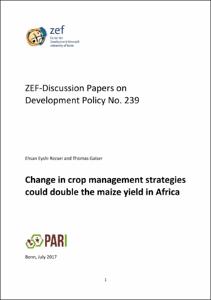Change in crop management strategies could double the maize yield in Africa

Change in crop management strategies could double the maize yield in Africa

| dc.contributor.author | Eyshi Rezaei, Ehsan | |
| dc.contributor.author | Gaiser, Thomas | |
| dc.date.accessioned | 2022-06-02T13:27:02Z | |
| dc.date.available | 2022-06-02T13:27:02Z | |
| dc.date.issued | 07.2017 | |
| dc.identifier.uri | https://hdl.handle.net/20.500.11811/9843 | |
| dc.description.abstract | Change in cropping practices is required to address the food security issues in Africa. Yet, testing of the performance of such changes, in particular at large scales, often needs significant investments. Crop models are widely used tools to quantify the effects of agronomic decisions on cropping systems and to identify the most promising areas for their advancement and implementation. Here in this study we quantify the impacts of individual and combined change in management scenarios including changes in (i) rates of nitrogen application, (ii) supplementary irrigation and (iii) new cultivar (with higher radiation use efficiency) on maize cropping systems over Africa based on 30 years (1980-2010) of climate, soil and management information obtained from global datasets at 0.5° x 0.5° spatial resolution. The crop model SIMPLACE was used in this study and it was tested against FAO statistics to evaluate the model performance under the current management conditions with traditional cultivars and average nitrogen application rates of < 10 kg N ha-1. The model results showed that the combined changes in crop management could improve the range of maize yield from 1.2 t ha-1 to 2.9 t ha-1 over the study period in Africa. The magnitude of the yield improvement is country and scenario specific. The largest maize yield improvements were obtained in the combined innovations rather than individual practices in particular for the supplementary irrigation. We conclude that it is essential to implement combined technology packages to fill the gap between attainable and current yield in Africa and that will require appropriate incentives, and investment in extension services, fertilizer distribution networks and farmer capacity strengthening. We also need to combine the results with a robust economic model to evaluate the benefits and risks of the required investments for such changes in crop management. | en |
| dc.format.extent | 30 | |
| dc.language.iso | eng | |
| dc.relation.ispartofseries | ZEF Discussion Papers on Development Policy ; No. 239 | |
| dc.rights | In Copyright | |
| dc.rights.uri | http://rightsstatements.org/vocab/InC/1.0/ | |
| dc.subject | Africa | |
| dc.subject | Crops | |
| dc.subject | Irrigation | |
| dc.subject | Fertilizer | |
| dc.subject | Agricultural production | |
| dc.subject.ddc | 620 Ingenieurwissenschaften und Maschinenbau | |
| dc.subject.ddc | 624 Ingenieurbau und Umwelttechnik | |
| dc.subject.ddc | 630 Landwirtschaft, Veterinärmedizin | |
| dc.title | Change in crop management strategies could double the maize yield in Africa | |
| dc.type | Arbeitspapier | |
| dc.publisher.name | Center for Development Research (ZEF) | |
| dc.publisher.location | Bonn | |
| dc.rights.accessRights | openAccess | |
| dc.relation.doi | https://doi.org/10.2139/ssrn.3005416 | |
| ulbbn.pubtype | Zweitveröffentlichung |




